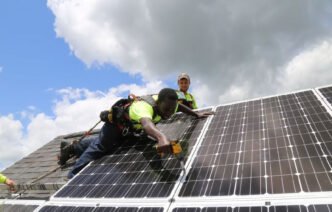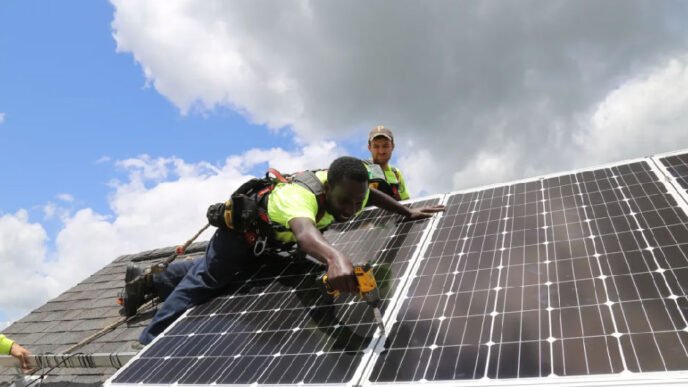Storms can wreak havoc on our homes and properties, leaving us feeling overwhelmed and unsure where to start. Whether it’s a hurricane, tornado, or severe thunderstorm, the aftermath can be devastating. But don’t worry—with the right approach, you can restore your property and get back to normal.
In this article, we’ll walk you through the storm damage restoration process step by step. We’ll cover everything from the initial safety checks to the final touches of reconstruction.
KEY TAKEAWAYS
- Prioritize safety and prevent further damage immediately after a storm.
- Conduct a thorough assessment to guide restoration and insurance claims.
- Remove water quickly and dry thoroughly to prevent mold growth.
- Use reconstruction as an opportunity to improve and upgrade your home.
Immediate Response and Safety Measures
When a storm hits, your first priority is safety. Once the storm passes, take a quick look around, but don’t put yourself in harm’s way. Watch out for downed power lines, unstable structures, or flooding. If you spot any serious hazards, call the professionals right away.
Next up, you’ll want to prevent any more damage from happening. This might mean covering broken windows with plywood or throwing a tarp over a damaged roof. Many homeowners find that contacting reputable restoration services early can help minimize long-term damage and streamline the recovery process.
Don’t forget to snap some photos for your insurance claim—they’ll come in handy later. Remember, acting fast can save you a lot of headaches (and money) down the road.
Comprehensive Damage Assessment
Now it’s time to get a full picture of the damage. This isn’t just a quick once-over—we’re talking about a thorough inspection from top to bottom. A professional will check your roof, walls, and foundation for any signs of trouble. They’ll also look for sneaky problems like water seeping into hidden spaces or potential mold growth.
But wait, there’s more! The assessment should also cover your home’s systems—think plumbing, electrical, and HVAC. Pros often use cool tech like thermal cameras to spot issues you can’t see with the naked eye. This detailed assessment is super important for your insurance claim and for planning out the restoration work ahead.
Water Removal and Drying Process
If your home’s taken on water, getting it out ASAP is crucial. The longer water hangs around, the more damage it can do. Restoration teams use heavy-duty equipment to suck up water from floors, carpets, and other surfaces. They’ll even use special techniques to draw moisture out of walls and other hard-to-reach spots.
Once the visible water’s gone, the drying process kicks into high gear. Industrial-strength fans and dehumidifiers will work around the clock to dry out your space. The team will keep a close eye on moisture levels, making sure everything’s bone-dry before moving on. This step is key in preventing mold growth and other nasty surprises down the line.
Cleaning and Sanitization
After drying comes the deep clean. This isn’t your average spring cleaning—we’re talking about a top-to-bottom scrub down. The team will tackle different surfaces with specialized cleaning methods, making sure to get rid of any gunk the storm left behind.
If you’re dealing with contaminated water or sewage backup, they’ll break out the heavy-duty sanitizers. But it’s not just about cleaning what you can see. Odor removal is a big part of the process too.
Storm damage often leaves behind some funky smells, and getting rid of them is important for making your space feel like home again. The pros have tricks up their sleeves to neutralize odors and leave your place smelling fresh and clean.
Structural Repairs and Reconstruction
Now we’re in the home stretch—it’s time to rebuild and repair. This stage is all about bringing your property back to its pre-storm glory (or even better). The team will start by fixing any structural issues, like reinforcing weakened walls or replacing damaged support beams.
It’s important to tackle these big problems first before moving on to the cosmetic stuff. From there, it’s on to replacing damaged materials like drywall, insulation, and flooring. This is also a great time to think about upgrades.
Maybe you want to install more energy-efficient windows or upgrade your electrical system. The reconstruction phase is your chance to not just restore, but improve your home. The goal is to leave you with a space that’s not only repaired but also better equipped to handle future storms.
Closing Thoughts
Dealing with storm damage is tough, but with the right approach, you can bounce back stronger than ever. By following these steps—from immediate safety measures to final reconstruction—you’ll be well on your way to restoring your property. Remember, professional help can make all the difference in ensuring a thorough and lasting restoration. Here’s to weathering any storm that comes your way!
Sponsored Post












